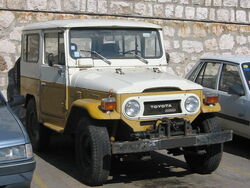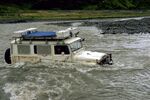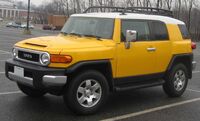 BJ40LV (Diesel) | |
| Manufacturer | Toyota |
|---|---|
| Also called | Toyota Macho(Venezuela) |
| Production |
1960–1984 1959–2001 (Brazil) |
| Predecessor | Toyota J20 series |
| Successor | Toyota J55 and J70 series |
| Class | Compact SUV |
| Body style(s) | 2-door truck |
The Toyota J40 is the model designation for a Toyota Land Cruiser 40 series made from 1960 until 1984 (in Brazil, where it was known as the Toyota Bandeirante , it was made from 1959 until 2001). Most 40 series Land Cruisers were built as two-door vehicles with slightly larger dimensions than a Jeep CJ.
The model was available as the FJ40 series (with F engines) and also BJ40/41/42 (short wheelbase), BJ43/44/46 (middle wheelbase) or HJ45/47 (long wheelbase) designation where it had a Diesel engine. Brazilian built Land Cruisers (Bandeirantes) with Mercede-Benz engines received OJ50-series modelcodes.
References to the series in this article will be to the J40 series unless referring to one of the petrol (FJ40/42 – 2WD) or diesel (BJ4#/HJ4#) models specifically.
History[]
For the history of the J series from the original 1951 Toyota Jeep BJ through the J20 series see Land Cruiser History from 1950 to 1955. For a more complete history of the Toyota Land Cruiser in the United States, see 'The History of the Toyota Land Cruiser' by Josh Boltrek at www.tlca.org.
- 1960 – J40 series launched. (wheelbase 2,285 mm (90 in)/2,430 mm (96 in)/2,650 mm (104 in)
- 1963 – Longer wheelbase (2,950 mm (116 in)), FJ45-B, pickup and cab-chassis were added
- 1967 – End of 4-door FJ45V (I) (w/b 2,650 mm (104 in)) production, replaced by FJ55 Station wagon
- – 2door FJ45-B renamed FJ45 (II) (w/b 2,950 mm (116 in))
- 1973? – HJ45 launched with the H , 3.6 litre in-line 6 cylinder Diesel engine.
- 1974 – BJ40/43 launched with the B, 3.0 litre in-line 4 cylinder diesel engine. A factory-fitted roll bar becomes standard in the United States.
- 1975 – Rear ambulance doors are added to US model FJ40s. The lift gate remains available as an option in other countries.
- 1976 – Disc brakes on the front axle.
- 1977 – Vent windows on the hard top in the United States
- 1979 – Power steering (only F models) and air conditioning added to the options, gear ratios modified from 4:10 to 3:70 in the United States to be more freeway friendly
- 1980 – HJ47 launched with a 4.0 liter 6 cylinder diesel engine. End of HJ45 production
- – BJ42/46 and BJ45 launched with a 3.4 liter 4 cylinder diesel engine
- 1981 – Power steering added on the BJ models to the options, Disk Brakes added in Australia
- 1984 – End of J40 series production (replaced by J70 series)
- 1993 – 5-speed transmission becomes avaliable for the Toyota Bandeirante[1]
- 1994 – In Brazil, the Mercedes-Benz OM-364 engine is replaced by the Toyota 14B unit
- 2001 – End of Bandeirante production
Models[]

a ZU-23-2 set on a Toyota 40series belong to Iranian Army during Iran-Iraq War
- The J40/41/42 was a two-door short wheelbase four wheel drive vehicle, with either a soft or a hard-top (V). It was available with various petrol or diesel (from 1974) engines over its lifetime. It was replaced on most markets from 1984 by the J70 series (70/71).
- The FJ42 is 4X2 model, for only The Middle East.
- The J43/J44/46 was an extremely rare two-door medium wheelbase four wheel drive vehicle, with either a soft or a hard-top (V). It was replaced on most markets from 1984 by the J70 series (73/74).
- The J45/47 was a long wheelbase four wheel drive vehicle, available in two door hard-top or four door station wagon or two door pickup models. The 4door station wagon model (FJ45V-I) was the shortest-lived of the J40 series, as it was replaced by the FJ55G/V in 1967.
- The Bandeirante (OJ50 / 55 / 55 B / 55 2B, BJ50 / 55 / 55 B / 55 2B) was a J40 series built in Brazil by Toyota do Brasil Ltda from 1959-2001. Identical to the BJ40 in almost every respect, it had a few stylistic modifications to the grille (models produced from 1989 on featured square headlights, instead of the round ones used before) and used Mercedes-Benz OM-314/OM-324/OM-364 diesel engines (replaced by Toyota 14B inline 4 direct injection Diesel engine in 1994) for much of its production life.
Paint Color Codes[]
| Code | Color |
|---|---|
| 012 | Cygnus White |
| 113 | Health Grey |
| 309 | Freeborn Red |
| 414 | Buffalo Brown |
| 415 | Pueblo Brown |
| 416 | Dune Beige |
| 464 | Beige |
| 474 | Dark Copper |
| 611 | Dark Green |
| 621 | Rustic Green |
| 622 | Nebula Green |
| 653 | Olive Green |
| 681 | Green |
| 808 | Horizontal Blue |
| 822 | Royal Blue |
| 854 | Sky Blue |
| 857 | Nordic Blue |
Engines[]
Over the years Toyota has changed the engines used in the J40 series. The B series motor is a 4 cylinder diesel, and the H series a 6 cylinder diesel. The diesel engined trucks were never sold to the general public in the USA, though some found their way in as mine trucks. The engines are similar, within the series. For example, the F and 2F engines share many of the same parts. However the H and 2H engines have almost nothing in common. There are individual models within the engine series, for example, there is an F125 engine, and an F155 engine, all in the F series with different power ratings. Here is a list of some of them (the power and torque figures may vary depending on the market):
| Engine | Capacity (l) | Power (hp) | Torque | Used |
|---|---|---|---|---|
| F | 3.8 | 105/125 | 189 lb·ft (256 N·m)/209 lb·ft (283 N·m) | 1960–1975 |
| 2F | 4.2 | 135 | 210 lb·ft (285 N·m) | 1975–1984 |
| Engine | Capacity (l) | Power (hp) | Torque | Used |
|---|---|---|---|---|
| B | 3.0 | 85 | 141 lb·ft (191 N·m) | 1974–1979 |
| 2B | 3.2 | 93 | 159 lb·ft (216 N·m) | 1979–1981 |
| 3B | 3.4 | 98 | 167 lb·ft (226 N·m) | 1979–1984 |
| H | 3.6 | 90 | 151 lb·ft (205 N·m) | 1972–1980 |
| 2H | 4.0 | 105 | 177 lb·ft (240 N·m) | 1980–1984 |
| OM324 | unknown | 78 | unknown | 1961-1973 (Bandeirante) |
| OM314 | 3.8 | 85 | 235 lb·ft (319 N·m) | 1973-1989 (Bandeirante) |
| OM364 | 4.0 | 90 | 235 lb·ft (319 N·m) | 1989-1994 (Bandeirante) |
| 14B | 3.7 | 96 | 240 lb·ft (325 N·m) | 1994-2001 (Bandeirante) |
Features[]

A 45LV (II) in action
- While not legal in some countries, most J40 series vehicles could have their roof and doors removed. With a folding windshield this allowed for complete open-air experience.
- The J40 Series also featured folding jump seats behind the passenger and drivers seats. These folding seats not only made carrying another 2 passengers possible, but also allowed for maximum cargo space, as opposed to the folding rear seat in the Jeep CJ series.
- Original factory winches were driven directly from the transfer case (known as P.T.O. or power take off) powered by the engine. Later models had an optional electric winch.
Future[]
There is a good sized following of people that collect, maintain, and drive their J-series truck off road. Toyota still offers many replacement parts, available through Toyota parts departments worldwide. Many of these trucks find their home in third world countries as work trucks, where they are used daily by their owners. Its essence lives on in the J70 series, which is essentially a J40 with an updated front half and slightly different engine offerings, such as a turbo charged diesel. It sells in many countries, but was never for sale in the USA.[2]

Toyota FJ Cruiser
Toyota has recently introduced the FJ Cruiser, a modern SUV styled after the original FJ40. The FJ Cruiser (FJC) went on sale in the spring of 2006.
Even though its production ended in Brazil many years ago, the Toyota Bandeirante is still very sought after, due to its good off-road performance. Thus Bandeirantes reach high prices in the Brazilian used car market, specially the rare 1993 models (the only ones fitted with a Mercedes-Benz engine and a 5-speed transmission).
References[]
- ↑ "E o Toyota passou". Best Cars Web Site (in Portuguese).
- ↑ "The Infamous Toyota FJ40". Automoblog.net.
| This page uses some content from Wikipedia. The original article was at Toyota Land Cruiser (J40). The list of authors can be seen in the page history. As with Tractor & Construction Plant Wiki, the text of Wikipedia is available under the Creative Commons by Attribution License and/or GNU Free Documentation License. Please check page history for when the original article was copied to Wikia |
| ||||||||||||||||||||